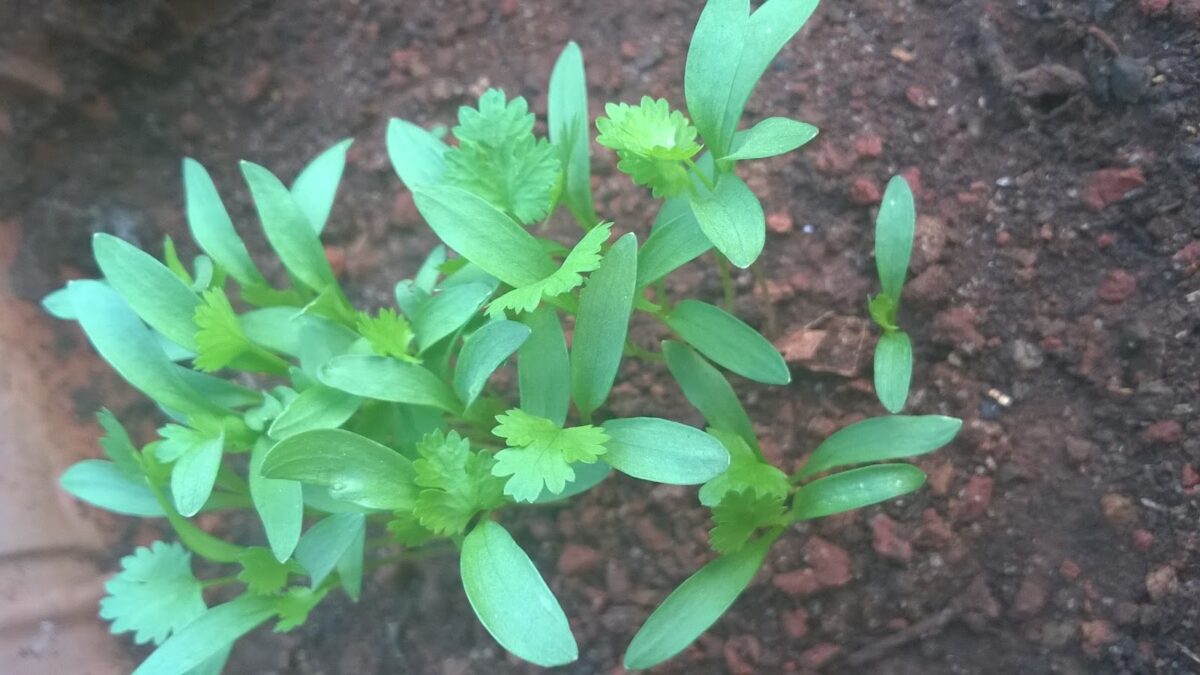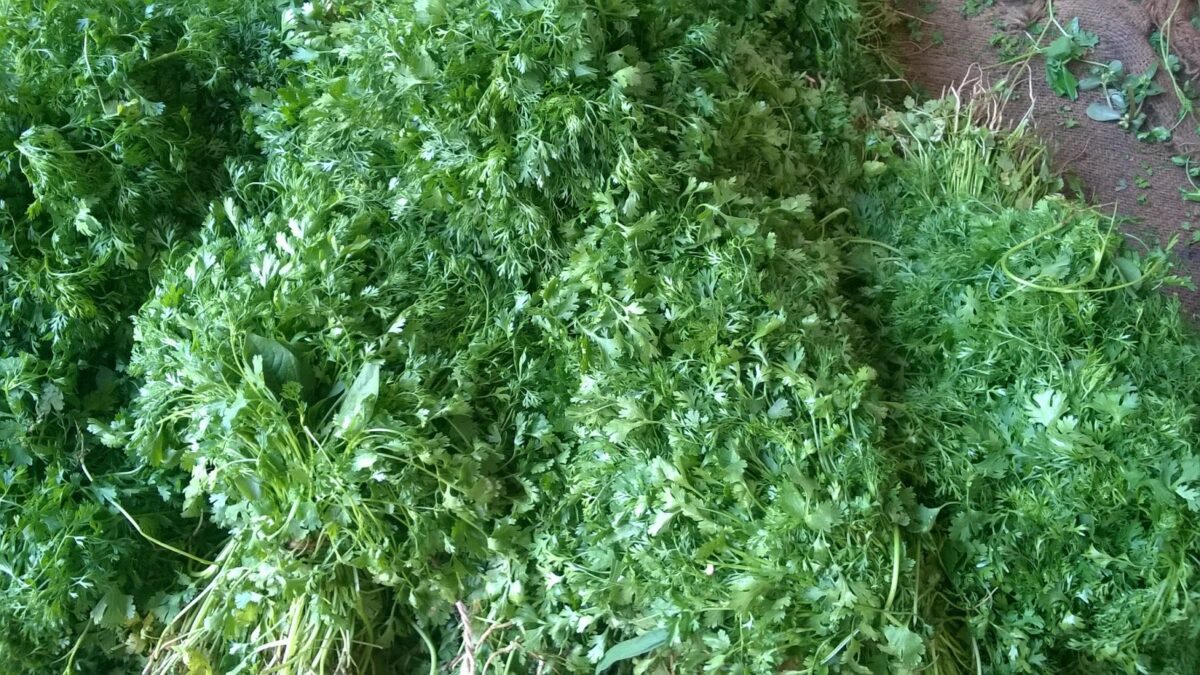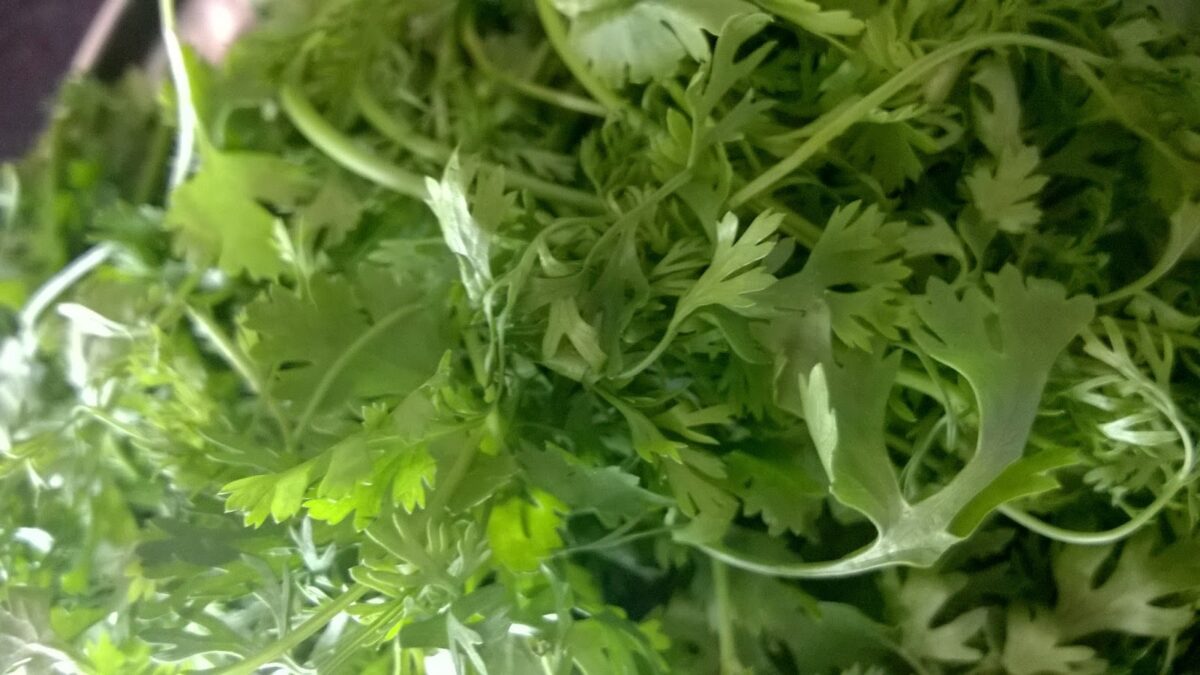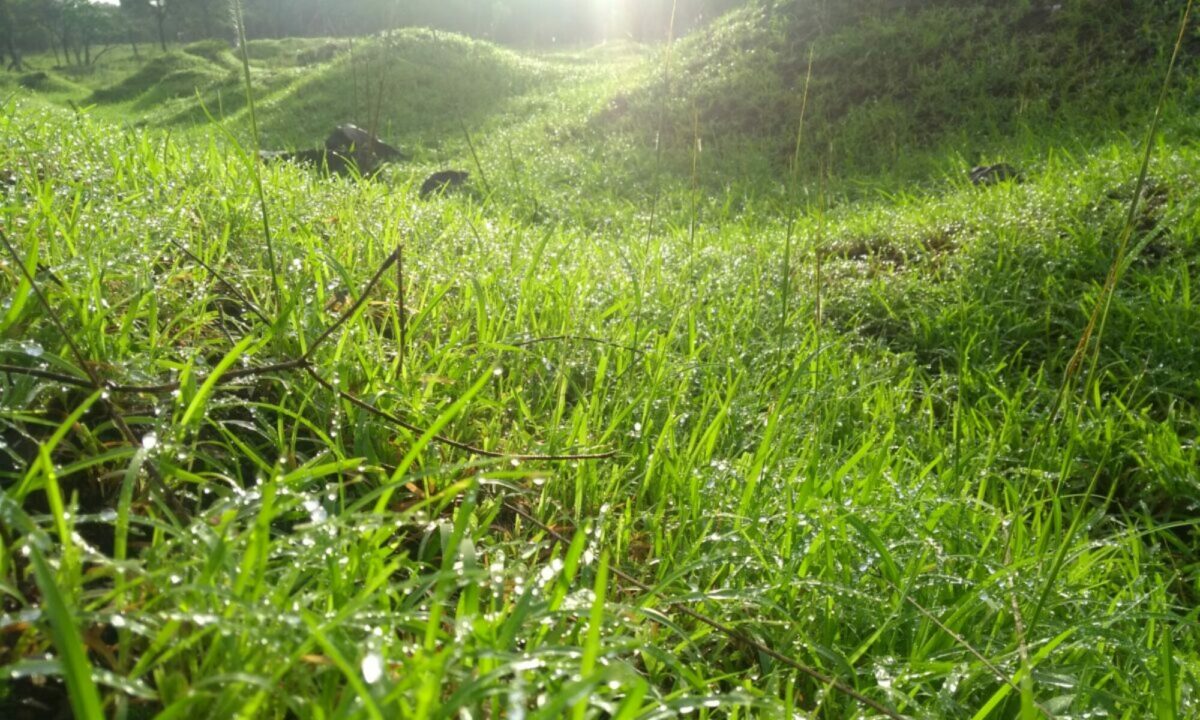Its still early days of the 2016 April AtoZ and I my posts are about herbs. I have tried to write about herbs that I have seen and identified, those that I use in my cooking.
D is for Dhania which is the Hindi word for Coriander or Kothimbir (in Marathi). This is my favourite seasoning and is an integral part of Maharashtrian cuisine. Almost every savoury dish is transported to a new level when garnished with chopped coriander. It lends a refreshing flavour and I find it reduces the heat in a spicy dish. While coriander is freely available almost all year round in Pune, the same was not true years ago in Punjab when we were posted there. This herb is mainly a winter plant and cannot stand the harsh summers. In North East India, we used a herb called Nagdhania (Eryngium foetidum of the Apiaceae family) as a substitute for regular Dhania during the summer.
Besides a wonderful flavour, the feathery Dhania leaves are extremely pretty and often used as part of salad decorations. The botanical name is Coriander sativum and it belongs to the Apiaceae family (Carrot family). Tender stems can be used to make chutney and the seeds are an important spice in Indian cuisine. However the leaves tend to lose flavour once the herb flowers. Seeds of this plant are used as a spice.
The Coriander inflorescence is said to be an Umbel. Umbel inflorescence is a characteristic of the Apiaceae, Asclepiadaceae and Taccaceae families. Identifying the inflorescence type in the field will help narrow down the search for species id.
Here is an image of tender shoots of Dhania in my fledgling herb garden!

D is for Dhania which is the Hindi word for Coriander or Kothimbir (in Marathi). This is my favourite seasoning and is an integral part of Maharashtrian cuisine. Almost every savoury dish is transported to a new level when garnished with chopped coriander. It lends a refreshing flavour and I find it reduces the heat in a spicy dish. While coriander is freely available almost all year round in Pune, the same was not true years ago in Punjab when we were posted there. This herb is mainly a winter plant and cannot stand the harsh summers. In North East India, we used a herb called Nagdhania (Eryngium foetidum of the Apiaceae family) as a substitute for regular Dhania during the summer.
Besides a wonderful flavour, the feathery Dhania leaves are extremely pretty and often used as part of salad decorations. The botanical name is Coriander sativum and it belongs to the Apiaceae family (Carrot family). Tender stems can be used to make chutney and the seeds are an important spice in Indian cuisine. However the leaves tend to lose flavour once the herb flowers. Seeds of this plant are used as a spice.
The Coriander inflorescence is said to be an Umbel. Umbel inflorescence is a characteristic of the Apiaceae, Asclepiadaceae and Taccaceae families. Identifying the inflorescence type in the field will help narrow down the search for species id.
Here is an image of tender shoots of Dhania in my fledgling herb garden!

As my bio says, I am a reluctant cook and I am sharing my Mom’s recipie of Kothimbir Vadi- a delicious snack or starter or meal accompaniment. It uses both leaves and powder of Dhania seeds.
 |
| Coriander leaves in the market |
 |
| Close up of coriander leaf |
Ingredients:
- Dhania patta (Corinader leaves)- one bunch
- Besan (Chick pea flour)- 2 or 3 teaspoons
- Hing (asafoetida) powder – half teaspoon
- Dhania and Jeera powder- half teaspoon
- Salt, chilli powder – to taste
- Water- if required – one fourth cup
- Cooking oil- two teaspoons and to line steaming tray
Method:
- Wash leaves well and drain on a towel for 10 minutes.
- Chop as finely as possible and mix in the spices, salt. Add besan one teaspoon at a time. The leaves tend to leave water hence additional water may not be required unless the leaves are totally dry. Continue to add besan as necessary till you get a sticky dough. Pour some oil over it and let it rest till you complete preparations for the next step.
- Prepare shallow steaming trays with a coating of oil.
- Spread the dhania and besan dough so its about one centimetre thick.
- Steam in a cooker for about 10 minutes
- Cool, cut into squares. It can be stored in the refrigerator for 3-4 days.
- The vadi can be consumed at this stage but it tastes better when shallow fried till crisp.
Recipe feedback welcome!
🙂

That sounds so good.
We use coriander in the States. However, we usually use the Spanish word which is Cilantro. It is delicious. We mix it with tomatoes, green chilies, jalapeno peppers and onions to make Salsa to eat with beans, rice, and other dishes.
I love Dhania. And I love to add it to almost everything.. 😀
Great post.
D is for Diapers
@Ann yes I have seen and tasted Cilantro and its wonderful! Thanks for sharing your cilantro salsa.
Thank you Seena!
I am halfway through preparing a Dhania-Pudina (Coriander-Mint) chutney and I landed up on this fantastic post.
Thank you for sharing the recipe will try it sometime 😀
Dhania Pudina chutney is god sent in this heat! I think I must make some too.. Thanks for this idea My Era! 🙂
I love fresh coriander leaves as well. And I am surely going to try your mother's recipe!!
I was neverso botanically leaned but always loved my dhania and it also helps in avoiding cramps. One glass coriander juice in the morning is pure magic.
@Natasha I am sure you will like it. Thanks for stopping by. 🙂
Thanks Karan. I have never tried Coriander juice but must think about it.
Dhania not only adds to the flavour of a dish but also lends it a very appetizing aroma. But there is much more to this humble leaf than just flavour.Coriander leaves contain some very essential nutrients like beta carotene, vitamin C, E, ferulic, caffeic acid, kaempferol and quercertin. All of these not only provide nutrition to your body but they also act as very strong antioxidant agents that help to clean up all the free radicals in our body – the ones that are responsible for causing cancer. Being a rich source of vitamin K, the tiny leaves present the body with an easy way so that it can be used efficiently by the body.
I agree… coriander adds a lot of fresh flavours to any dish. aND AS nOVEMBER's Child mentioned, it is packed full of wonderful nutrients.
I've never cooked with Dhania (I haven't made many Indian dishes) but I've definitely used cilantro/coriander in Mexican cooking, and it adds a great flavor.
I do not the the leaf of the plant which we call cilantro. But I do like the coriander seed which is completely different taste.
@Novemberschild Thank you for adding this vital info. We need to include it in our preparations for these reasons above all else.
I love dhania but hate the wadis. I love the aroma of coriander and find it refreshing always
@bellybytes Thanks for your frank comment. Not everybody likes the wadi. So happy that you have stopped by… 🙂
Thank you Roshan! I agree with Novemberschild too!
@Sarah Cilantro is great! I have used it occasionally. Thanks for sharing your thoughts.
@Denise- yes the coriander seed has a totally different flavour from the leaf.. Both unique in their own ways. Thank you 🙂
My fav fav fav! Can't imagine an Indian curry without it 🙂 Thanks for sharing this information as well.
Thanks Shalini 🙂 🙂